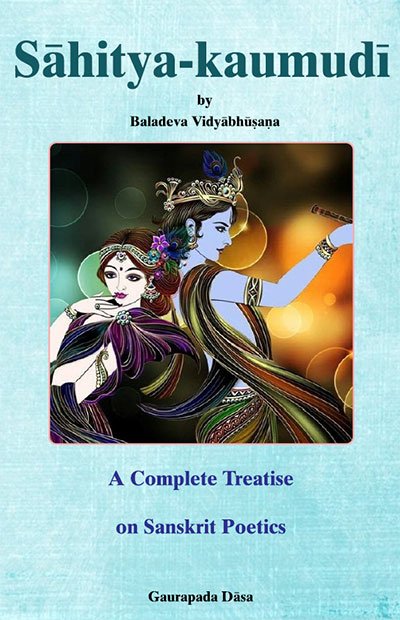Sahitya-kaumudi by Baladeva Vidyabhushana
by Gaurapada Dāsa | 2015 | 234,703 words
Baladeva Vidyabhusana’s Sahitya-kaumudi covers all aspects of poetical theory except the topic of dramaturgy. All the definitions of poetical concepts are taken from Mammata’s Kavya-prakasha, the most authoritative work on Sanskrit poetical rhetoric. Baladeva Vidyabhushana added the eleventh chapter, where he expounds additional ornaments from Visv...
Text 4.40
अथ व्यभिचारिणः,
atha vyabhicāriṇaḥ,
Now the vyabhicārīs are enumerated:
nirveda-glāni-śaṅkākhyās tathāsūyā-mada-śramāḥ |
ālasyaṃ caiva dainyaṃ ca cintā mohaḥ smṛtir dhṛtiḥ ||4.31||
vrīḍā capalatā harṣa āvego jaḍatā tathā |
garvo viṣāda autsukyaṃ nidrāpasmāra eva ca ||4.32||
suptaṃ prabodho’marṣaś cāpy avahittham athogratā |
matir vyādhis tathonmādas tathā maraṇam eva ca ||4.33||
trāsaś caiva vitarkaś ca vijñeyā vyabhicāriṇaḥ |
trayas-triṃśad amī bhāvāḥ samākhyātās tu nāmataḥ ||4.34||
The names of the thirty-three vyabhicāri-bhāvas are: nirveda (self-disparagement) (disgust toward material life), glāni (witheredness of body) (or mlāni), śaṅkā (apprehension), asūyā (envy, jealousy; resentment; fault-finding coupled with disrespect), mada (intoxication; being crazed), śrama (fatigue), ālasya (laziness), dainya (meekness, being miserable), cintā (pondering), moha (bewilderment to the point of a diminution of internal awareness), smṛti (remembrance), dhṛti (steadfastness of the heart) (or dhairya), vrīḍā (bashfulness, shame) (or lajjā), capalatā (fickleness), harṣa (joy), āvega (confusion, mental flurry), jaḍatā (indolence), garva (arrogant pride), viṣāda (remorse, despair, dejection, languor), autsukya (eagerness, longing), nidrā (sleepiness), apasmāra (convulsion), supta (dreaming), prabodha[1] (enlightenment: having a realization), amarṣa (indignation), avahittha (concealment) (or avahitthā), ugratā (ferocity), mati (thoughtfulness, especially as regards the scriptures), vyādhi (a specific mental agony, such as fever), unmāda (high madness), maraṇa (deathlike symptoms), trāsa (sudden fear), and vitarka (conjecture).
eṣv ātmany ayogyatā-mananaṃ nirvedaḥ, citta-sambhrama āvegaḥ, kāla-yāpanākṣamatvam autsukyam, duḥkhottha-dhātu-vaiṣamyādyutthā citta-viluptir apasmāraḥ, suptaṃ svapnaḥ, ākāra-guptir avahittham, caṇḍatvam ugratā, artha-nirdhāro matiḥ, hṛd-bhrāntir unmādaḥ, spaṣṭam anyat. lakṣyāṇy ūhyāni. iha nirvedasyābhadraprāyasyāpi prāg upādānāt tasya śānta-sthāyitvaṃ vihitam. tam evāha.
Among them, nirveda means considering oneself incompetent, āvega means mental confusion, autsukya means not tolerating the passage of time, apasmāra means the impairment of the mind, arisen from the instability of bodily constituents, and so on, which arises from sorrow, supta means dreaming, avahittha means concealing a form, ugratā means being fierce, mati means ascertaining a meaning, and unmāda denotes the confusion of the heart. The rest is clear. The secondary characteristics can be inferred.
Although nirveda is almost inauspicious, its being the sthāyī of śānta is ordained since here it is mentioned first. That is just what he talks about next.
